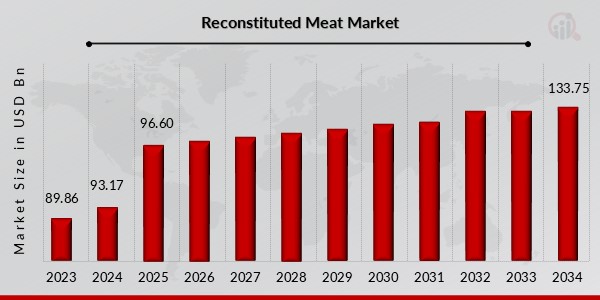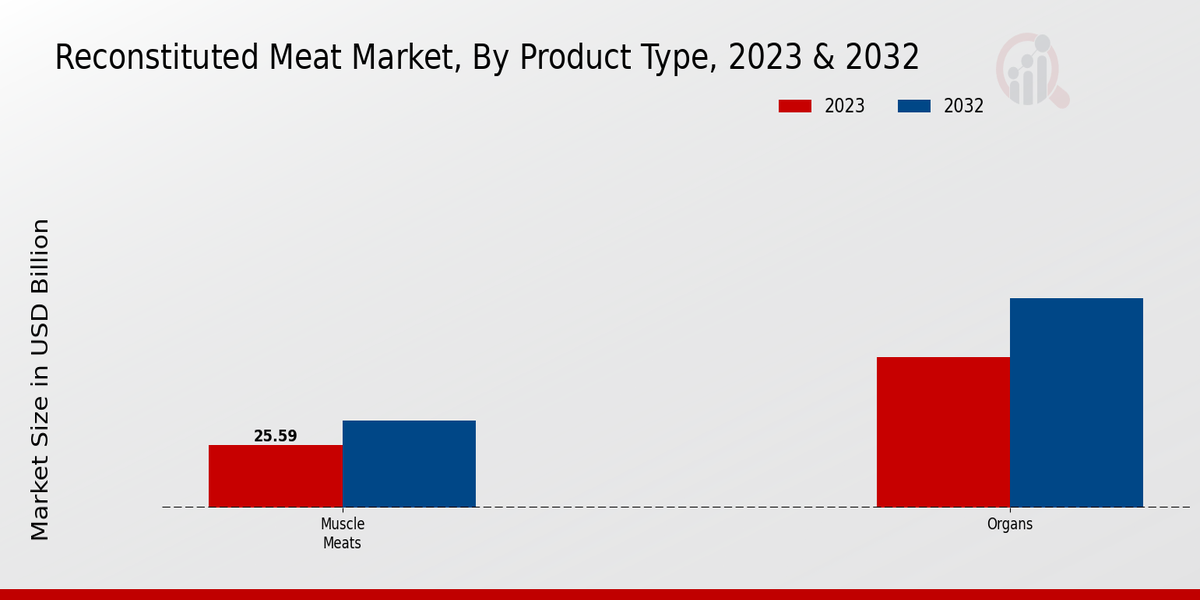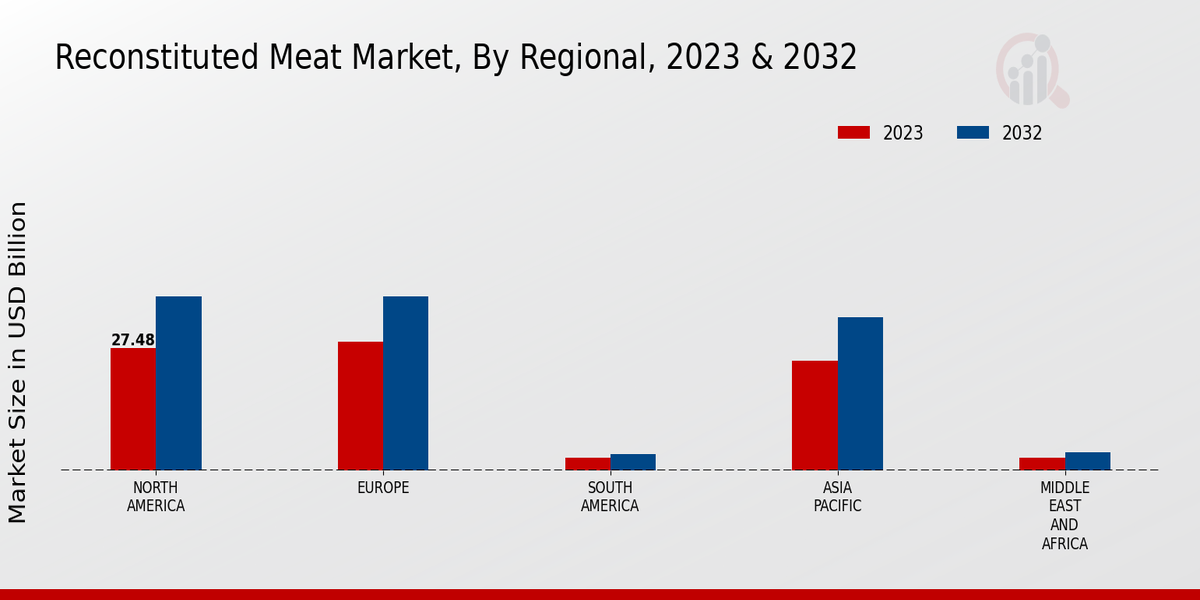Global Reconstituted Meat Market Overview
Reconstituted Meat Market Size was estimated at 93.17 (USD Billion) in 2024. The Reconstituted Meat Industry is expected to grow from 96.60 (USD Billion) in 2025 to 133.75 (USD Billion) by 2034. The Reconstituted Meat Market CAGR (growth rate) is expected to be around 3.7% during the forecast period (2025-2034).

Source Primary Research, Secondary Research, MRFR Database and Analyst Review
Key Reconstituted Meat Market Trends Highlighted
The reconstituted meat market is poised for significant growth, driven by factors such as increasing demand for convenient and affordable protein sources, rising urbanization, and changing dietary preferences.
Key market opportunities include the development of innovative products that cater to specific consumer needs, such as low-fat and high-protein reconstituted meat.
Recent trends in the reconstituted meat market include the growing adoption of advanced technologies to enhance production efficiency and product quality. Additionally, there is a growing emphasis on sustainable practices and traceability throughout the supply chain.
This trend is expected to continue as consumers become more aware of the environmental and social impacts of their food choices.
Another emerging trend in the reconstituted meat market is the adoption of plant-based ingredients. This trend is driven by increasing consumer demand for healthier and more sustainable food options.
As a result, manufacturers are investing in developing plant-based reconstituted meat products that offer taste and texture similar to traditional meat products.
Reconstituted Meat Market Drivers
Rising Demand for Convenient and Ready-to-Eat Meat Products
The reconstituted meat market is anticipated to witness substantial growth in the coming years, primarily driven by the rising demand for convenient and ready-to-eat meat products. This trend is particularly prevalent in fast-paced urban environments, where consumers seek quick and easy meal options.
Reconstituted meat products, such as reconstituted bacon, sausage, and patties, offer a convenient alternative to traditional meat products, as they can be easily prepared and consumed without the need for extensive preparation or cooking.
Furthermore, the increasing popularity of meal delivery services has fueled the demand for reconstituted meat products, as they can be easily incorporated into pre-packaged meals and delivered to consumers' doorsteps.
The growing number of working professionals and time-constrained individuals is also contributing to the surge in demand for convenient and ready-to-eat meat products, including reconstituted meat.
Technological Advancements in Reconstituted Meat Production
The Reconstituted Meat Market is undergoing a transformation due to technological advancements in production processes. These advancements are focused on enhancing the quality, safety, and efficiency of reconstituted meat production.
One significant advancement is the development of innovative extrusion technologies, which enable the production of reconstituted meat products with improved texture, flavor, and nutritional value. Additionally, the adoption of advanced packaging technologies, such as modified atmosphere packaging (MAP) and vacuum packaging, extends the shelf life of reconstituted meat products, reducing spoilage and waste.
These technological advancements are not only improving the quality and safety of reconstituted meat products but also optimizing production processes, leading to increased efficiency and cost reduction.
Growing Health Consciousness and Focus on Sustainable Meat Consumption
The Reconstituted Meat Market is influenced by the growing health consciousness among consumers. The rising prevalence of chronic diseases, such as obesity and cardiovascular diseases, has led to a shift in consumer preferences toward healthier and more sustainable meat consumption.
Reconstituted meat products, which are often perceived as healthier alternatives to traditional meat products due to their lower fat and cholesterol content, are gaining popularity among health-conscious consumers.
Moreover, the growing awareness of environmental sustainability has prompted consumers to seek out meat products that are produced in an environmentally responsible manner. Reconstituted meat production offers a sustainable solution, as it utilizes less energy, water, and land resources compared to traditional meat production.
Reconstituted Meat Market Segment Insights
Reconstituted Meat Market Product Type Insights
The Reconstituted Meat Market is segmented by product type into muscle meats, organs, and other product types. Muscle meats hold the dominant share of the market and are projected to continue their dominance throughout the forecast period.
The growth of the muscle meats segment can be attributed to the increasing demand for processed meat products, such as sausages, burgers, and meatballs. Organs, such as liver and kidney, also constitute a significant portion of the market. Other product types, such as blood and plasma, are used in the production of a variety of food products, including soups, sauces, and pet food.
The growing demand for convenience foods is also contributing to the growth of the market. However, the market faces several challenges, such as the rising cost of raw materials and the increasing prevalence of vegan and vegetarian diets.
The Reconstituted Meat Market is a highly competitive market, with a few major players. Some of the key players in the market include JBS S.A., Tyson Foods, Inc., and Smithfield Foods, Inc. These companies are investing in research and development to improve their product offerings and expand their market share.

Source Primary Research, Secondary Research, MRFR Database and Analyst Review
Reconstituted Meat Market Distribution Channel Insights
The distribution channel segment of the Reconstituted Meat Market is categorized into retail, foodservice, and online. Among these, the retail segment held the largest market share in 2023, accounting for over 60% of the Reconstituted Meat Market revenue.
This dominance is attributed to the extensive presence of supermarkets, hypermarkets, and convenience stores, which offer a wide variety of reconstituted meat products to meet the diverse needs of consumers.
The food service segment is projected to exhibit a significant CAGR during the forecast period, driven by the increasing popularity of reconstituted meat products in restaurants, hotels, and other food service establishments.
The online segment is also anticipated to grow at a notable pace, fueled by the rising adoption of e-commerce platforms for grocery shopping.
Reconstituted Meat Market Form Insights
The Reconstituted Meat Market segmentation by Form includes Fresh, Frozen, and Processed. The Processed segment held the largest market share in 2023, and it is expected to continue to dominate the market during the forecast period.
The Processed segment includes value-added products such as sausages, burgers, and bacon, which are gaining popularity due to their convenience and taste. The Frozen segment is expected to witness the highest growth rate during the forecast period, as it offers a longer shelf life and allows for easy storage and transportation.
The Fresh segment includes raw meat that is not frozen or processed, and it is expected to hold a steady market share during the forecast period.
Reconstituted Meat Market Application Insights
The application segment of the reconstituted meat market is categorized into ready-to-eat meals, soups and stews, sauces and marinades, and other applications. Ready-to-eat meals held the largest market share in 2023, owing to the growing demand for convenience foods.
The increasing popularity of meal delivery services and the rising number of working women are contributing to the growth of this segment. The soups and stews segment is also expected to witness significant growth, driven by the increasing demand for healthy and nutritious food options.
Sauces and marinades are another important application segment, as they are widely used in various cuisines to enhance the flavor and texture of dishes. The other applications segment includes products such as pet food, bakery products, and snacks.
This segment is expected to grow steadily over the forecast period, owing to the increasing demand for processed meat products. In 2023, the reconstituted meat market size was valued at 86.66 billion U.S. dollars, and it is projected to reach 120.0 billion U.S. dollars by 2032, growing at a CAGR of 3.68%.
The market growth is attributed to factors such as rising demand for convenience foods, increasing population, and growing urbanization.
Reconstituted Meat Market Protein Source Insights
The Reconstituted Meat Market is segmented by protein source into beef, pork, poultry, and other protein sources. Beef is the largest segment, accounting for over 55% of the market in 2023. Pork is the second largest segment, with a share of around 25%.
This growth will be driven by the increasing consumption of reconstituted meat in emerging markets, such as China and India, and the development of new and innovative reconstituted meat products. Key players in the Reconstituted Meat Market include JBS SA, Tyson Foods, Inc., OSI Group, LLC, and Cargill, Incorporated.
These companies are investing in new technologies and products to meet the growing demand for reconstituted meat.
Reconstituted Meat Market Regional Insights
The Reconstituted Meat Market is segmented into North America, Europe, APAC, South America, and MEA. In 2023, North America held the largest market share, accounting for approximately 35% of the Reconstituted Meat Market revenue.
Europe followed, with a market share of 30%. APAC is expected to grow at the highest CAGR during the forecast period, due to increasing demand from developing countries such as China and India. South America and MEA are also expected to see steady growth in the coming years.
The Reconstituted Meat Market is driven by factors such as rising meat prices, growing demand for processed foods, and increasing awareness of the health benefits of reconstituted meat.
The market is also supported by government regulations and initiatives to promote healthy eating.

Source Primary Research, Secondary Research, MRFR Database and Analyst Review
Reconstituted Meat Market Key Players and Competitive Insights
Major players in the Reconstituted Meat Market are constantly striving to gain a competitive edge by investing in research and development, expanding their product portfolios, and implementing strategic partnerships.
Leading Reconstituted Meat Market players are focusing on developing innovative products that cater to the evolving needs of consumers. The Reconstituted Meat Market is characterized by intense competition, with key players adopting various strategies to maintain their market positions.
Leading Reconstituted Meat Market players are focusing on expanding their geographical presence through mergers and acquisitions, joint ventures, and partnerships. The competitive landscape is expected to remain dynamic, with new entrants and established players vying for market share.
One of the prominent competitors in the Reconstituted Meat Market is Tyson Foods, Inc. The company offers a wide range of reconstituted meat products, including formed and portion-controlled items. Tyson Foods has a vast distribution network and a strong brand presence, which enables it to reach a large customer base.
The company is committed to innovation and sustainability, and it invests heavily in research and development to enhance its product offerings. Another major competitor in the Reconstituted Meat Market is Cargill, Incorporated.
The company produces a comprehensive line of reconstituted meat products, including ground beef, patties, and formed products. Cargill has a presence and a strong supply chain, which allows it to meet the needs of customers in various markets.
The company is focused on providing customized solutions and technical support to its customers. Additionally, JBS S.A. is a leading player in the Reconstituted Meat Market. The company has a significant presence in South America and is expanding its operations globally.
JBS S.A. offers a wide range of reconstituted meat products, including value-added and branded products. The company is committed to quality and sustainability, and it has implemented various initiatives to reduce its environmental impact.
These leading competitors are actively involved in the Reconstituted Meat Market development, and they are constantly seeking new opportunities to expand their market share and enhance their competitive positions.
Key Companies in the Reconstituted Meat Market Include
- Danish Crown
- Smithfield Foods
- Cargill
- OSI Group
- Dawn Foods
- OSI Food Solutions
- Marfrig Foods
- Olymel
- Tyson Foods
- Moy Park
- Hormel Foods
- Maple Leaf Foods
- JBS S.A.
- NH Foods
- Vion
Reconstituted Meat Market Developments
Recent developments in the Reconstituted Meat Market include the growing demand for plant-based alternatives, rising health consciousness among consumers, and technological advancements in production processes.
Key players in the market include OSI Group, Tyson Foods, JBS, and Cargill, among others. Strategic initiatives such as acquisitions, partnerships, and new product launches are shaping the competitive landscape.
The market is expected to witness significant growth potential in emerging economies, driven by increasing urbanization and changing dietary patterns.
Reconstituted Meat Market Segmentation Insights
- Reconstituted Meat Market Product Type Outlook
- Muscle Meats
- Organs
- Other Product Types
- Reconstituted Meat Market Distribution Channel Outlook
- Retail
- Foodservice
- Online
- Reconstituted Meat Market Form Outlook
- Reconstituted Meat Market Application Outlook
- Ready-to-Eat Meals
- Soups and Stews
- Sauces and Marinades
- Other Applications
- Reconstituted Meat Market Protein Source Outlook
- Beef
- Pork
- Poultry
- Other Protein Sources
- Reconstituted Meat Market Regional Outlook
- North America
- Europe
- South America
- Asia-Pacific
- Middle East and Africa
| Report Attribute/Metric |
Details |
| Market Size 2024 |
93.17(USD Billion) |
| Market Size 2025 |
96.60(USD Billion) |
| Market Size 2034 |
133.75(USD Billion) |
| Compound Annual Growth Rate (CAGR) |
3.7% (2025 - 2034) |
| Report Coverage |
Revenue Forecast, Competitive Landscape, Growth Factors, and Trends |
| Base Year |
2023 |
| Market Forecast Period |
2025 - 2034 |
| Historical Data |
2019 - 2023 |
| Market Forecast Units |
USD Billion |
| Key Companies Profiled |
Danish Crown, Smithfield Foods, Cargill, OSI Group, Dawn Foods, OSI Food Solutions, Marfrig Foods, Olymel, Tyson Foods, Moy Park, Hormel Foods, Maple Leaf Foods, JBS S.A., NH Foods, Vion |
| Segments Covered |
Product Type, Distribution Channel, Form, Application, Protein Source, Regional |
| Key Market Opportunities |
Growing health consciousness Increasing demand for convenient food options Expansion of e-commerce platforms Rising adoption in the foodservice industry Innovation in flavors and textures |
| Key Market Dynamics |
Rising Demand for Convenient Food Options Growing Health Consciousness Increase in Processed Meat Consumption Technological Advancements in Food Processing Sustainability Concerns |
| Countries Covered |
North America, Europe, APAC, South America, MEA |
Frequently Asked Questions (FAQ) :
The reconstituted meat market was valued at approximately USD 96.60 billion in 2025 and is projected to reach a value of around USD 133.75 billion by 2032, exhibiting a CAGR of roughly 3.7% during the forecast period.
The increasing demand for convenient and affordable meat products, rising consumer awareness about the environmental impact of traditional meat production, and technological advancements in the production of reconstituted meat are the primary factors driving the growth of the reconstituted meat market.
North America is expected to hold the largest market share in the reconstituted meat market throughout the forecast period due to the presence of major market players, high adoption of advanced technologies, and increasing health consciousness among consumers.
Reconstituted meat finds applications in various food products, including sausages, burgers, meatballs, and other processed meat products. It is also used as a meat extender in ground beef and other meat products to reduce costs and improve texture.
Key competitors in the reconstituted meat market include Beyond Meat, Impossible Foods, Kellogg Company, Cargill, and Tyson Foods. These companies are investing heavily in research and development to improve the taste, texture, and nutritional value of their reconstituted meat products.
The reconstituted meat market faces challenges related to consumer perception, regulatory approvals, and the availability of raw materials. Some consumers may have concerns about the nutritional value and taste of reconstituted meat compared to traditional meat.
The reconstituted meat market presents opportunities for growth due to the rising demand for plant-based meat alternatives, increasing investments in research and development, and growing consumer awareness about sustainability.
The reconstituted meat market is influenced by trends such as the increasing popularity of flexitarian and vegan diets, the development of new and innovative meat alternatives, and the adoption of sustainable practices in the food industry.
The reconstituted meat market is projected to Register a CAGR of approximately 3.7% from 2025 to 2034, driven by the aforementioned factors.
The reconstituted meat market is segmented based on type (reconstituted red meat, reconstituted poultry meat, and reconstituted seafood), application (sausages, burgers, meatballs, and other processed meat products), distribution channel (modern trade, convenience stores, and online retailers), and region (North America, Europe, Asia-Pacific, and the Rest of the World).

















